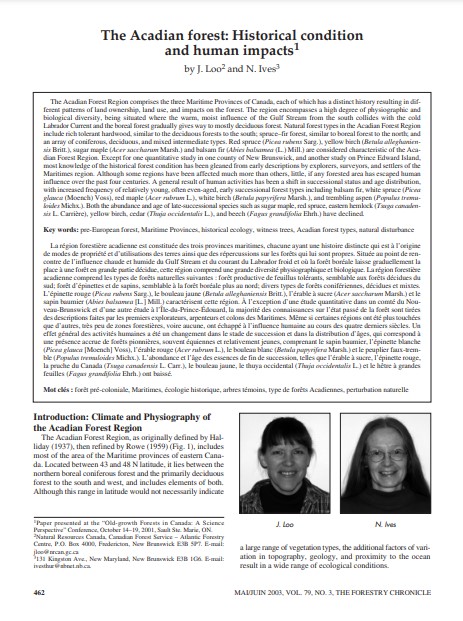The Acadian forest: Historical condition and human impacts.
Bosque Modelo:
Fundy
Temática:
Cambio climático
Tipo de documento:
Artículo científico
Resumen
The Acadian Forest Region comprises the three Maritime Provinces of Canada, each of which has a distinct history resulting in different patterns of land ownership, land use, and impacts on the forest. The region encompasses a high degree of physiographic and biological diversity, being situated where the warm, moist influence of the Gulf Stream from the south collides with the cold Labrador Current and the boreal forest gradually gives way to mostly deciduous forest. Natural forest types in the Acadian Forest Region include rich tolerant hardwood, similar to the deciduous forests to the south; spruce–fir forest, similar to boreal forest to the north; and an array of coniferous, deciduous, and mixed intermediate types. Red spruce (Picea rubens Sarg.), yellow birch (Betula alleghaniensis Britt.), sugar maple (Acer saccharum Marsh.) and balsam fir (Abies balsamea (L.) Mill.) are considered characteristic of the Acadian Forest Region. Except for one quantitative study in one county of New Brunswick, and another study on Prince Edward Island, most knowledge of the historical forest condition has been gleaned from early descriptions by explorers, surveyors, and settlers of the Maritimes region. Although some regions have been affected much more than others, little, if any forested area has escaped human influence over the past four centuries. A general result of human activities has been a shift in successional status and age distribution, with increased frequency of relatively young, often even-aged, early successional forest types including balsam fir, white spruce (Picea glauca (Moench) Voss), red maple (Acer rubrum L.), white birch (Betula papyrifera Marsh.), and trembling aspen (Populus tremuloides Michx.). Both the abundance and age of late-successional species such as sugar maple, red spruce, eastern hemlock (Tsuga canadensis L. Carrière), yellow birch, cedar (Thuja occidentalis L.), and beech (Fagus grandifolia Ehrh.) have declined.
Información Bibliográfica
Autor:
Loo, J and N Ives.
Revista:
Forestry Chronicle
Año:
2003
N°:
3
País :
Canadá
Páginas:
462 - 474
Volumen:
79
Idioma:
Ingles
Palabras claves
: pre-European forest, Maritime Provinces, historical ecology, witness trees, Acadian forest types, natural disturbance





